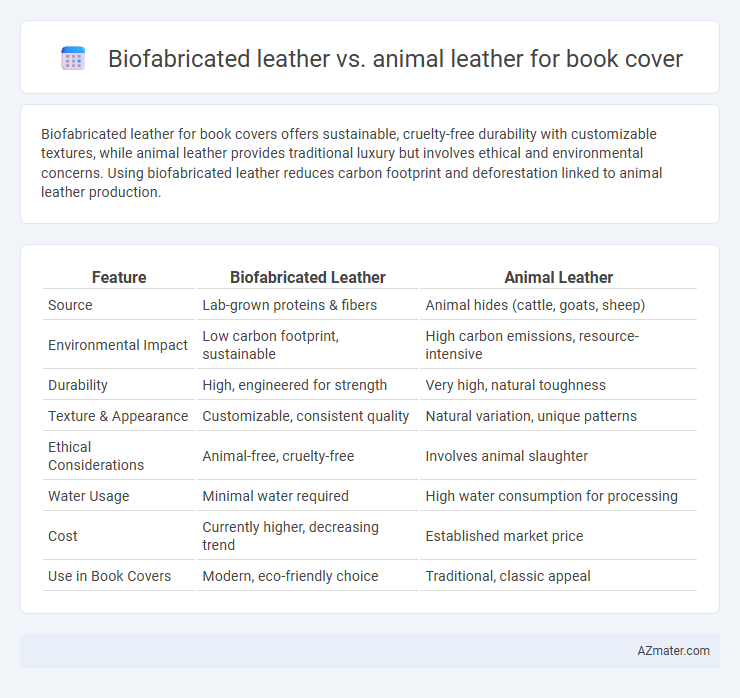Biofabricated leather for book covers offers sustainable, cruelty-free durability with customizable textures, while animal leather provides traditional luxury but involves ethical and environmental concerns. Using biofabricated leather reduces carbon footprint and deforestation linked to animal leather production.
Table of Comparison
| Feature | Biofabricated Leather | Animal Leather |
|---|---|---|
| Source | Lab-grown proteins & fibers | Animal hides (cattle, goats, sheep) |
| Environmental Impact | Low carbon footprint, sustainable | High carbon emissions, resource-intensive |
| Durability | High, engineered for strength | Very high, natural toughness |
| Texture & Appearance | Customizable, consistent quality | Natural variation, unique patterns |
| Ethical Considerations | Animal-free, cruelty-free | Involves animal slaughter |
| Water Usage | Minimal water required | High water consumption for processing |
| Cost | Currently higher, decreasing trend | Established market price |
| Use in Book Covers | Modern, eco-friendly choice | Traditional, classic appeal |
Introduction to Biofabricated and Animal Leather
Biofabricated leather is a sustainable alternative to traditional animal leather, produced through cellular agriculture by culturing animal cells or plant-based materials to mimic the texture and durability of conventional leather. Animal leather is derived from the hides of livestock, primarily cattle, and undergoes tanning processes to transform rawhide into a flexible and wearable material. Both materials offer unique properties for book covers, with biofabricated leather emphasizing eco-friendly production and reduced environmental impact compared to the resource-intensive and emission-heavy processes associated with animal leather.
Material Composition and Production Processes
Biofabricated leather for book covers is created using cultured animal cells or plant-based materials that mimic the structure of traditional leather, offering a sustainable alternative that reduces reliance on animal hides. Animal leather is derived from tanned animal skins, undergoing chemical treatments and water-intensive processes that contribute to its durability and distinct texture. The production of biofabricated leather involves biotechnological methods and controlled environments, resulting in a customizable and eco-friendly material, while animal leather production remains resource-intensive with a significant environmental footprint.
Environmental Impact Comparison
Biofabricated leather significantly reduces environmental impact compared to traditional animal leather by minimizing greenhouse gas emissions and water usage during production. Unlike animal leather, which contributes to deforestation, methane emissions, and excessive pesticide use in cattle farming, biofabricated leather uses cellular agriculture methods that require fewer natural resources. This sustainable alternative offers a lower carbon footprint and promotes eco-friendly manufacturing practices for book cover materials.
Durability and Longevity
Biofabricated leather offers enhanced durability and longevity compared to traditional animal leather due to its engineered fibers designed to resist wear, tear, and environmental factors. Unlike animal leather, which can degrade over time with exposure to moisture and UV light, biofabricated leather maintains structural integrity and appearance much longer. This makes biofabricated leather a superior choice for book covers that require lasting protection and aesthetic appeal.
Aesthetic and Textural Differences
Biofabricated leather offers a consistent, customizable texture with a smooth or patterned finish, ideal for premium book covers seeking modern aesthetics. In contrast, animal leather exhibits natural grain variations and unique imperfections that enhance the tactile richness and vintage appeal of book bindings. The tactile experience of biofabricated leather is often softer and more uniform, while animal leather provides a deeper, more organic texture that ages with character over time.
Ethical Considerations
Biofabricated leather offers a cruelty-free alternative to traditional animal leather, eliminating the need for animal slaughter and addressing concerns related to animal welfare. It reduces the environmental impact associated with livestock farming, such as greenhouse gas emissions and deforestation, aligning with sustainable production ethics. Choosing biofabricated leather for book covers supports ethical consumerism by promoting innovation in cruelty-free, eco-friendly materials without compromising quality and durability.
Cost and Market Availability
Biofabricated leather for book covers typically incurs higher production costs compared to conventional animal leather, reflecting advanced biotechnology and smaller-scale manufacturing processes. Animal leather remains widely available and generally less expensive due to established supply chains and mass production, making it the dominant choice for bookbinding. Market availability of biofabricated leather is limited but growing, targeting premium and sustainable product segments where consumers value innovation over cost.
Customization and Design Flexibility
Biofabricated leather offers unparalleled customization and design flexibility compared to traditional animal leather, enabling precise control over texture, thickness, and color through advanced laboratory processes. Its production allows for innovative patterns and finishes that are difficult or impossible to achieve with animal hides, supporting unique, personalized book cover aesthetics. This versatility not only enhances visual appeal but also aligns with sustainable and ethical design preferences in modern publishing.
Consumer Perceptions and Preferences
Consumer perceptions of biofabricated leather for book covers highlight a preference for sustainable and cruelty-free materials, with many valuing its innovative production process and environmental benefits. Animal leather remains favored for its traditional durability, luxury appeal, and tactile quality, although ethical concerns lead some consumers to seek alternatives. Market trends indicate growing acceptance of biofabricated leather as a viable, eco-friendly substitute, especially among younger, environmentally conscious readers.
Future Trends in Book Cover Materials
Biofabricated leather offers a sustainable and cruelty-free alternative to traditional animal leather for book covers, combining durability with eco-friendly production methods. Innovations in biofabrication utilize plant-based proteins and microbial fermentation to create customizable textures and enhanced wear resistance. Future trends indicate a growing preference for biodegradable and vegan materials in book cover manufacturing, driven by consumer demand for ethical and environmentally responsible products.

Infographic: Biofabricated leather vs Animal leather for Book cover
 azmater.com
azmater.com